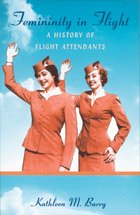nonfiction
Sky Girls
A look at the glamorous— and activist—history of flight attendants
by Andrea Crawford
In February 1930, a young woman named Ellen Church walked into a meeting at Boeing Air Transport. Trained as a nurse and a pilot, Church pitched an unusual idea: She suggested that the airline hire nurses to serve passengers. At a time when flights were rough, air-sickness rampant, and emergency landings far too commonplace, her medical expertise, she argued, would be an asset in the air.Airlines had been ferrying passengers along with mail and cargo since the early 1920s, and many had experimented with male stewards, in vogue on trains and ocean liners. The Boeing manager, however, immediately grasped the power that women would have on board. Their presence would reassure passengers—with "great psychological punch," he noted—that this new mode of travel was both safe and respectable. It would also, he predicted, earn his airline enormous national publicity. Three months later, on a 10-passenger plane flying the Oakland-Cheyenne-Chicago route, the world's first "stewardesses" took to the air.
The great success of Church's idea is chronicled in Kathleen M. Barry's Femininity in Flight: A History of Flight Attendants (Duke University Press). In the account, Barry (GSAS '02) argues that those stylish attendants who pampered elegant passengers with seven-course meals, cigars, cocktails, fresh flowers—and, in old sleeper accommodations, even breakfast in bed—were on the forefront of labor history. Among the first to use the Civil Rights Act of 1964 to fight sexual discrimination, for example, they were pioneers in the air and in the courts.
Barry's story travels a rich history: from the first adventurous women flying during the Depression to the mid-century "Golden Era" of flight when "well-heeled air travelers enjoyed leisurely flights on roomy, well-appointed planes," and flight attendants, as she writes, "could borrow plenty of prestige from both customer and setting." The history continues through the hypersexualized late 1960s and early '70s, describing how National Airlines, for example, ran an infamous advertising campaign featuring a beautiful flight attendant and the headline, "I'm Cheryl—Fly Me" (which soon transformed into "I'm Going to Fly You Like You've Never Been Flown Before"). Barry ends her study with weight-restriction battles that carried into the 1990s and an aviation bill that finally, in 2003, legislated safety requirements for flight attendants, certification for which they had been lobbying for decades.
From the time Barry began researching the topic while a graduate student in history at NYU, the activism angle intrigued her: "Just the idea that these women who are seen as genteel and glamorous actually set up a union in the 1940s—it flies in the face of the stereotype." The book details, for example, the fight to overturn outrageous rules that for decades forced "retirement" upon marriage and age limits as young as 32. In 1965, when several stewardesses appeared before a House Labor Subcommittee to fight industry age discrimination, New York Representative James H. Scheuer asked them to stand so he and his colleagues could "visualize the dimensions of the problem." To the Congressmen, Barry writes, "the more interesting matter was not stewardesses' function in commercial aviation but the age at which women ceased to be attractive."
Nevertheless, recent years have seen a strong sense of nostalgia for the so-called glamour of those days, and even as their jobs grow more difficult, flight attendants have become a potent symbol of a lost time when air travel was both elegant and pleasurable. Due in part to the downgrading of services since deregulation, it is also certainly a psychological response to the fact that flying has become so scary. "We can look back to this golden age," Barry says, "and think, Oh, wasn't that nice? Everyone behaved themselves and wore white gloves, and you didn't have to worry about terrorism."








